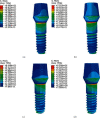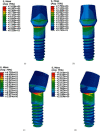The Effect of Abutment Angulation and Crown Material Compositions on Stress Distribution in 3-Unit Fixed Implant-Supported Prostheses: A Finite Element Analysis
- PMID: 36065400
- PMCID: PMC9440824
- DOI: 10.1155/2022/4451810
The Effect of Abutment Angulation and Crown Material Compositions on Stress Distribution in 3-Unit Fixed Implant-Supported Prostheses: A Finite Element Analysis
Abstract
Objective: The aim of this study was to evaluate influence of abutment angulation and restoration material compositions on the stress pattern in dental implants and their surrounding bone.
Materials and methods: In this finite element study, the six different solid 3D models of "mandibular 3-unit fixed implant-supported prostheses" were analyzed. In all of these models, a straight abutment was used for anterior implants at the second premolar site, and in order to posterior implant at the second molar site, abutments with three different angles (straight, 15, and 20°) were used. Also, two different restoration material compositions (porcelain fused to base metal (PFBM) and porcelain fused to noble metal (PFNM)) were considered for fixed implant supported restorations. A 450 N static force was exerted in a straight manner along the longitudinal axis of the anterior implant in a tripod, and the stress distribution was measured based on the restoration materials and abutment angulations of the models in the 3 sites of cortical, cancellous bone, and fixtures. The simulation was performed with ABAQUS 6.13 Software.
Results: In all models, stress values in surrounding cortical bone were more than in spongy bone. Maximum stress levels in an anterior abutment-implant complex were seen in models with angled implants. In models with parallel implants, the stress level of a molar straight abutment-implant complex was less than that of premolar straight ones. In an angled posterior abutment-implant complex, less stress level was detected compared to straight ones. In all PFNB models, stress values were slightly more and distributed in a wider area of premolar straight abutments.
Conclusion: Increasing an abutment angle, increases stress in surrounding bone and straight implant-abutment combination. It seems that the crown material composition affects stress distribution of the implant-abutment combination but does not affect stress distribution of surrounding bone.
Copyright © 2022 Ramin Mosharraf et al.
Conflict of interest statement
The authors declare that they have no conflicts of interest.
Figures








References
-
- Meriç G., Erkmen E., Kurt A., Tunç Y., Eser A. Influence of prosthesis type and material on the stress distribution in bone around implants: a 3-dimensional finite element analysis. Journal of Dental Science . 2011;6(1):25–32. doi: 10.1016/j.jds.2011.02.005. - DOI
LinkOut - more resources
Full Text Sources

